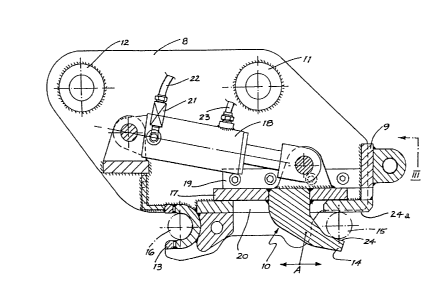Some of the information on this Web page has been provided by external sources. The Government of Canada is not responsible for the accuracy, reliability or currency of the information supplied by external sources. Users wishing to rely upon this information should consult directly with the source of the information. Content provided by external sources is not subject to official languages, privacy and accessibility requirements.
Any discrepancies in the text and image of the Claims and Abstract are due to differing posting times. Text of the Claims and Abstract are posted:
| (12) Patent: | (11) CA 1329627 |
|---|---|
| (21) Application Number: | 568828 |
| (54) English Title: | QUICK RELEASE HYDRAULIC HITCH FOR CONSTRUCTION EQUIPMENT AND EXCAVATORS |
| (54) French Title: | ATTELAGE HYDRAULIQUE A DESACCOUPLEMENT RAPIDE POUR MATERIEL DE CHANTIER |
| Status: | Deemed expired |
| (52) Canadian Patent Classification (CPC): |
|
|---|---|
| (51) International Patent Classification (IPC): |
|
| (72) Inventors : |
|
| (73) Owners : |
|
| (71) Applicants : | |
| (74) Agent: | NORTON ROSE FULBRIGHT CANADA LLP/S.E.N.C.R.L., S.R.L. |
| (74) Associate agent: | |
| (45) Issued: | 1994-05-17 |
| (22) Filed Date: | 1988-06-07 |
| Availability of licence: | N/A |
| (25) Language of filing: | English |
| Patent Cooperation Treaty (PCT): | No |
|---|
| (30) Application Priority Data: | None |
|---|
ABSTRACT
A hitch assembly for mounting onto the articulated arm of
a hydraulic excavator, backhoe or the like comprising
remotely operable means (14) for releasibly grasping the
hinge pins (15, 16) of a bucket, rock hammer or other
device whereby such implements can be quickly and easily
interchanged without removal of said pins.
Note: Claims are shown in the official language in which they were submitted.
Note: Descriptions are shown in the official language in which they were submitted.

For a clearer understanding of the status of the application/patent presented on this page, the site Disclaimer , as well as the definitions for Patent , Administrative Status , Maintenance Fee and Payment History should be consulted.
| Title | Date |
|---|---|
| Forecasted Issue Date | 1994-05-17 |
| (22) Filed | 1988-06-07 |
| (45) Issued | 1994-05-17 |
| Deemed Expired | 2008-05-20 |
There is no abandonment history.
| Fee Type | Anniversary Year | Due Date | Amount Paid | Paid Date |
|---|---|---|---|---|
| Application Fee | $0.00 | 1988-06-07 | ||
| Maintenance Fee - Patent - Old Act | 2 | 1996-05-17 | $50.00 | 1996-05-10 |
| Maintenance Fee - Patent - Old Act | 3 | 1997-05-20 | $50.00 | 1997-05-06 |
| Maintenance Fee - Patent - Old Act | 4 | 1998-05-19 | $50.00 | 1998-05-13 |
| Maintenance Fee - Patent - Old Act | 5 | 1999-05-17 | $75.00 | 1999-05-17 |
| Maintenance Fee - Patent - Old Act | 6 | 2000-05-17 | $75.00 | 2000-05-03 |
| Maintenance Fee - Patent - Old Act | 7 | 2001-05-17 | $75.00 | 2001-05-10 |
| Maintenance Fee - Patent - Old Act | 8 | 2002-05-17 | $75.00 | 2002-05-06 |
| Maintenance Fee - Patent - Old Act | 9 | 2003-05-20 | $75.00 | 2003-05-06 |
| Maintenance Fee - Patent - Old Act | 10 | 2004-05-17 | $125.00 | 2004-05-13 |
| Maintenance Fee - Patent - Old Act | 11 | 2005-05-17 | $125.00 | 2005-05-06 |
| Back Payment of Fees | $125.00 | 2006-05-17 | ||
| Maintenance Fee - Patent - Old Act | 12 | 2006-05-17 | $125.00 | 2006-05-17 |
Note: Records showing the ownership history in alphabetical order.
| Current Owners on Record |
|---|
| ESSEX, STUART ALEXANDER |
| ESSEX, WENDY PAMELA |
| Past Owners on Record |
|---|
| None |